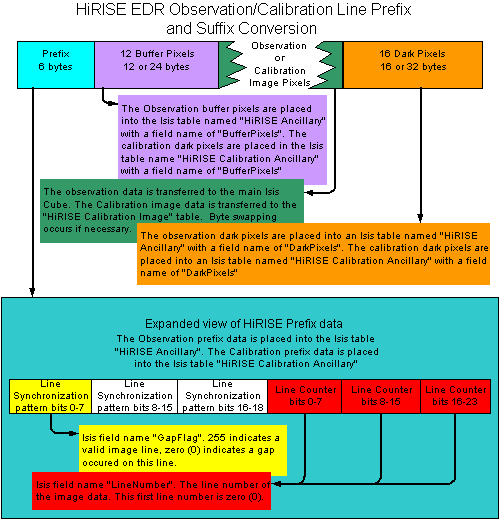Converts a single channel HiRISE EDR into an Isis Cube file.
The observation image data from the EDR is transfered into the Isis Cube data.
The observation line prefix and suffix data will be combined into a single Isis table
named "HiRISE Ancillary". The calibration image data will be placed into an Isis
table named "HiRISE Calibration Image", and the calibration line prefix and suffix
data will be combined into a single Isis table named "HiRISE Calibration Ancillary".
8 bit EDR pixels are checked for invalid values in the following order:
gaps (255 = 0xFF), high instrument saturation (254 = 0xFE), and low
instrument saturation (0 = 0x00). See the following table for what these
values are converted to. Once the special pixels have been delt with the
8 bit data is processed in one of two ways depending on the UNLUT
parameter. If UNLUT is false then the 8 bit values are simply moved into
a signed 16 bit integer without modifying their magnitude. If UNLUT is
true, the 8 bit values are converted to their 14 bit value by applying
the lookup table and stored in a signed 16 bit integer. The lookup table
from the EDR labels contaings 256 pairs of 14 bit values. The first pair
is the range of 14 bit pixels that were compressed to 8 bit pixel value
zero (0). The second pair is the range compressed to pixel value one (1),
and so on. 8 bit pixels are mapped to the corresponding average of the
14 bit lookup table range.
16 bit EDR pixels are checked for invalid values in the following order:
gaps (-1 = 0xFFFF), low order byte appears to be the beginning of a gap
(0x??FF), outside of unsigned 14 bit range (0 to 16383), high instrument saturation
(16383 = 0x3FFF), and low instrument saturation (0 = 0x0000).
Since the byte order of all HiRISE
EDR products is most significant byte first all integer values within the EDR
will be converted to the native byte order of the machine running "hi2isis"
unless the cube attribute specifies otherwise.
The line prefix and suffix data for the calibration and observation image are converted
and stored into their respective tables in the same manner as the image pixels.
The Isis tables which hold
prefix and suffix data have four, four byte integer fields. These are "Gap Flag",
"LineNumber", "BufferPixels", and "DarkPixels". The BufferPixel field contains twelve
integers and the DarkPixel field contains sixteen integers. Other information from the
EDR prefix tables such as the synchronization pattern are not transfered to the Isis file.
The "GapFlag" is taken directly from byte zero of the EDR line prefix data and is stored
in the least significant byte of the four byte field integer. The upper three bytes are set to all
zeros. The byte from the EDR has two possible values, all zeros and all ones. This means
the Isis GapFlag value as an integer has two possible values, 255 and zero (0).
The "LineNumber" is taken from bytes three, four and five of the EDR line prefix data and
is stored into a single four byte integer with the most significant byte set to zero.
The twelve values for "BufferPixels" are taken from the EDR line prefix buffer pixels.
8-bit buffer pixels are converted to 16 bit values in exactly the same way as image pixels.
All buffer pixels are stored in the
corresponding Isis "BufferPixels" array. All pixel values will be
stored in the low order two bytes and will be swapped if the native byte order is least
significant byte first.
The sixteen values for "DarkPixels" are taken from the EDR line suffix dark pixels, and are
handled in the same manner as the buffer pixels.

| Stuart Sides | 2004-04-26 |
Original version
|
| Stuart Sides | 2004-06-15 |
Updated according to new SIS. Added Calibration, Ancillary calibration
and Ancillary Image BLOBs.
|
| Stuart Sides | 2004-10-18 |
Added documentation specific to the Isis tables that are created.
|
| Stuart Sides | 2004-10-22 |
Fixed a bug with the allocation of the TableField "image". It now works for
HiRISE EDRs that have a binning mode other than one (1).
|
| Stuart Sides | 2005-02-28 |
Added gap and lookup table handling. Both 8 and 16 bit inputs are now
converted to 16 bit output. The lookup table for 8 bit is applied. The output
DN for an 8 bit input is the average of the lookup table range values. Added
new option (LSBGAP) to handle 16 bit pixels with a low order byte of 0xff immediately
before a gap. By default, this new option will convert these pixels to a gap. With
the option turned off, these pixels will be left unaltered.
|
| Stuart Sides | 2005-06-27 |
Added the parameter UNLUT to give the ability to apply the 8 to 14 bit
look up table or not. Also fixed problem with gaps, LIS and HIS being reported
correctly but not converted correctly to double precision values before
being inserted into the BUFFER.
|
| Stuart Sides | 2005-07-21 |
Added new keywords to the results group. For each of the six sections, the
program now outputs the number gaps, LIS, HIS, PossibleGaps, and Invalid
pixels.
|
| Stuart Sides | 2006-04-07 |
Fixed a bug with signedword data where gaps were being reported as LIS
instead of gap. Added more progress information.
|
| Brendan George | 2006-06-14 |
Removed call to OriginalLabel, ProcessImportPds now handles this
|
| Brendan George | 2006-09-26 |
Documentation fixes
|
| Brendan George | 2007-01-17 |
Added blob testing to default appTest
|
| Christopher Austin | 2008-03-18 |
Checks if input file is rdr.
|
| Steven Lambright | 2008-05-13 |
Removed references to CubeInfo
|
| Steven Lambright | 2011-04-18 |
Removed a line of code that didn't make sense
|
